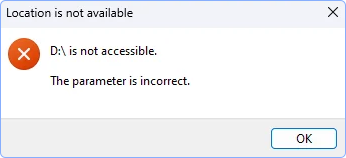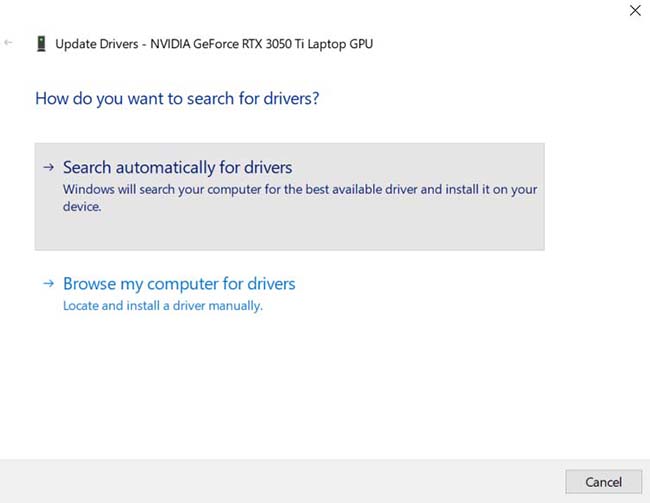How to Fix “The Parameter Is Incorrect | Drive Is Not Accessible” Error in Windows
| “I recently did a system restore on my laptop […]. With everything I do, there’s a notice telling me that the “parameter is incorrect.” I can’t open my device manager, run admin, open downloads, and many more things. I still run into “parameter is incorrect” while following the [online advice]. Any suggestions? Should I bring it to a repair shop or something? I don’t know.”
– From Microsoft Community |
|---|
| “All my client’s photos are stored on the hard drive—it’s coming up with the above error […]. My brother did a bit of research, and it said […] do a chkdsk/f/r, which we have done, but it is still on 11% (and it’s been running for 2 days). Do I take it out? What do I do next? How do I recover the images? I’m really stressing out.”
– From WD Community |
|---|
User queries like these on various online forums reflect a common scenario faced by many. Encountering errors—especially cryptic ones like “Drive is not accessible. The parameter is incorrect”—while trying to access important files can be very frustrating. In this article, we are going to discuss this error and how to get rid of it without losing data.
“Drive [D:\] is not accessible. The parameter is incorrect” error message usually appears in Windows 11, 10, or earlier versions when you attempt to access external storage media like a hard disk drive (HDD), SSD, USB stick, or SD card. This error implies that Windows is unable to access the data stored in the external drive.

What Does “Drive Is Not Accessible. The Parameter Is Incorrect” Error Mean?
“Drive is not accessible. The parameter is incorrect” indicates that there is a potential problem with the external storage device, usually related to file system corruption, data integrity, driver compatibility, user permissions, or physical damage.
This error often occurs at the time of carrying out file operations, making hardware connections, or configuring networks. It prevents you from accessing the drive or the files stored on it. However, Windows does not give specific details about its root cause.
Common Causes of the Error
| Reasons | Description |
|---|---|
| 🗂️ File System Corruption | A file system defines how data is stored, organized, and accessed on the storage device. Windows may return this error if the file system is corrupted. |
| 🔧 💾 Outdated Drivers | Outdated drivers can cause problems ranging from system instability to software or hardware performance lag. So, if the drivers are outdated, it can cause the “the parameter is incorrect” error. |
| 🧩 Corrupted Windows System Files | Corrupted Windows system files break the communication between the computer and the drive, resulting in this error message. |
| 💢 Bad Sectors | The OS may fail to execute the command correctly if there are a significant number of bad sectors on the HDD, causing error messages. |
| 🦠 Virus Infection | Malicious software can target specific parts of the external storage system, resulting in this error. |
| 🔌 Power Failure | A sudden power failure can cause read/write issues on the drive, leading to Windows returning this error message. |
How to Fix “The Parameter Is Incorrect” Error?
This section will address all viable methods to troubleshoot and resolve “The parameter is incorrect” error on your external storage device.
Fix 1: Perform Basic Checks
The error can stem from minor issues like loose cables or faulty USB ports. These basic checks help you to identify whether it’s a software- or hardware-related problem.
- Reconnect the external drive using a different cable or a different USB port.
- Try using a different PC to rule out any issue with the original computer.
Fix 2: Run CHKDSK Utility
You can run the Disk Check utility on Command Prompt. Here’s how to use it.
- Type cmd (command prompt) in the search box in your taskbar.
- Right-click on the Command Prompt icon and select Run as Administrator.

- Type chkdsk X: /f /r and hit Enter.
(Replace X: with the letter designated to your external drive.)
- This command will scan the drive for errors and attempt to repair them. The time it takes to run the command depends on the capacity of the drive, its health, and the amount of data stored on it.
Fix 3: Run SFC in Command Prompt
The System File Checker (SFC) is a tool built into all versions of Windows. It helps you to repair corrupted system files in Windows. SFC ensures the system’s stability by addressing boot errors and device detection problems.
- In the Windows search bar, type cmd, right-click on the Command Prompt icon, and click on Run as Administrator.
- Type SFC/scannow and hit Enter.

- Once the scanning is complete, exit Command Prompt.
- Restart your PC and try reconnecting your device to see whether the problem is resolved.
Fix 4: Update Drivers
Outdated drivers hinder the communication between the system and the hardware. The following steps are for updating the drivers to fix the “The parameter is incorrect” error.
- Press Windows + X and select Device Manager.
- Navigate to Disk Drives, select your external hard drive, right-click on it, and then click on Update driver.

- Click Search automatically for drivers and follow the prompts to install the compatible drivers for your device.

- If no driver updates are available, you can try uninstalling and reinstalling the disk drivers.
Fix 5: Run Antivirus Software
Malware attacks can also cause “The parameter is incorrect” error. Go to the start menu and type Virus & Threat Protection in the search bar. Click on the icon, and scan the external drive for viruses. If you see any malware threat, neutralize it with the antivirus software and restart your PC.
Use a Professional Data Recovery Service
If none of the abovementioned DIY methods work, consider reaching out to a professional data recovery service. You might be dealing with complex logical issues or even physical damage. Repeatedly trying DIY methods will likely worsen the damage and reduce the chances of a successful data recovery.
Stella Data Recovery has over thirty years of experience successfully recovering data from external HDDs, SSDs, pen drives, SD cards, and other media. With access to state-of-the-art infrastructure, cutting-edge technology, and proprietary tools, trained professionals carry out device inspection, cloning, and data recovery procedures in controlled environments.
So, if you are unable to resolve “the parameter is incorrect” error on your own, you should immediately consult Stellar’s data recovery experts. Alternatively, you can visit the official website, fill in the details of the issue you are facing, and hit the “Request a Call Back” button. A data recovery expert will reach out to you promptly.
Preventive Measures
To avoid facing similar issues in the future, you need to adopt a few preventive measures.
- Ensure regular backups of crucial data.
- Run antivirus software regularly.
- Connect/disconnect external devices carefully.
- Keep disk drivers updated to avoid compatibility issues.
Conclusion
“The parameter is incorrect” error implies that Windows is unable to access the data stored in the external drive. You can try the CHKDSK and SFC commands to repair the drive. However, if the error keeps recurring, you should seek the help of a professional data recovery service.
Facing Other Drive Errors?
If “The parameter is incorrect” error isn’t the only issue you’ve come across, you might also find the following guides helpful in resolving other common storage device problems:
- If your drive suddenly asks to format and becomes unreadable, you might be facing a file system issue. Understand what causes it and how to fix “You need to format the disk in drive before you can use it” error.
- When your system throws a data error while copying or reading files, it’s likely due to disk surface issues. Learn how to fix Cyclic Redundancy Check (CRC) error.
- If your computer shows a warning during boot-up indicating imminent disk failure, it could be a hardware-level fault. Find out why it happens and how to fix SMART Hard Disk Error Code 301.
- Seeing a black screen with a boot device not found message? Your system may be unable to detect the hard drive. Explore possible causes and solutions for the Hard Disk Error 3F1 in Windows.







